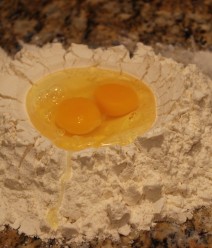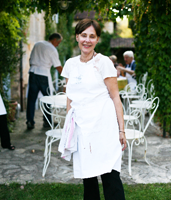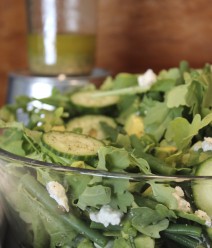Flaky Buttermilk Biscuits from Carla Hall
Ingredients
- 8 tablespoons (4 ounces) unsalted butter, frozen, plus more, for the pan
- 2 1/2 cups (310g) all-purpose flour, plus more for shaping the dough (if measuring by cups, be sure to stir the flour in the container first, scoop into the cup, then level off, without tapping the flour down)
- 1 tablespoon baking powder
- 1 teaspoon granulated sugar
- 1 teaspoon salt
- 1/2 teaspoon baking soda
- 2 tablespoons vegetable shortening, at room temperature
- 1 1/2 cups whole-milk buttermilk, cold
Directions
- Butter a half-sheet pan.
- To make the dough with a food processor: Combine the flour, baking powder, sugar, salt, and baking soda in a food processor fitted with the blade attachment. Pulse a few times, until well mixed. Add the shortening and pulse until fine crumbs form. Switch to the grating disk attachment. With the machine running, push the frozen butter through the feed tube.
- To make the dough with a food processor (continued): Transfer the mixture to a large bowl and toss to make sure all the butter shreds are coated with the floury crumbs. Make a well in the center of the flour, add most of the buttermilk, and fold in using a rubber spatula, running the flat edge of it through the center of the mixture like a hash mark and then around the edge while you rotate the bowl. Keep at it, while being as gentle as possible, until the dry ingredients are evenly moistened—it will look wetter than you think it should. If there are still dry crumbly bits, stir in the rest of the buttermilk.
- To make the dough by hand: Mix the flour, baking powder, sugar, salt, and baking soda in a large bowl with an open hand, using your fingers to whisk. Add the shortening and use your fingertips to pinch and rub it completely into the flour until the mixture resembles coarse crumbs, making sure you scrape around the bottom of the bowl to coat all the flour in shortening. If you feel any lumps of shortening, rub the flour through the palms of your hands to work it all in.
- To make the dough by hand (continued): Roll your frozen butter in the dry ingredients to make it easier to handle. Using a box grater, grate the frozen butter on the large holes into the flour. Anytime the butter warms up and gets slippery, roll it in the flour again. As you go, shake the grated butter into the flour once or twice and toss to coat it evenly. When you’re done grating, make sure all pieces are coated with flour, then quickly and lightly pinch them into the flour. Make a well in the center of your flour, add most of the buttermilk to the flour mixture, and fold using a rubber spatula, running the flat edge of it through the center of the mixture like a hash mark and then around the edge while you rotate the bowl. Keep at it, while being as gentle as possible, until the dry ingredients are evenly moistened—it will look wetter than you think it should. If there are still dry crumbly bits, stir in the rest of the buttermilk.
- Lightly coat your work surface with neutral oil or nonstick cooking spray, then flour. (The spray keeps the flour in place.) Sprinkle a little more flour in the center of the board.
- Turn the dough out onto the prepared surface and gently toss it around like a cat playing with a ball of yarn, until the sticky ball of dough is covered in a thin layer of flour. Pat into a 1/2-inch-thick rectangle. Sprinkle the dough with flour, then fold it in thirds like a letter. Repeat the patting, sprinkling and folding twice, rotating the dough 90° each time. Pat the dough into 3/4-inch thickness. It should no longer be sticky.
- Flour a 2-inch-round biscuit cutter (or clean, hollowed out can) and press it straight down to cut the dough, then twist to remove the biscuit. Transfer the round to the buttered pan, placing the bottom side up. Repeat, cutting the rounds as close together as possible, and spacing them 1 inch apart on the pan. Gather the scraps, smoosh them between your palms to 3/4-inch thickness, lay the dough flat, and cut again. Refrigerate the rounds until cold, at least 15 minutes.
- In the meantime, heat the oven to 450°F.
- Bake the biscuits until the tops are golden brown and crisp, about 16 minutes. Let cool for 5 minutes on the pan before serving hot.
- To make ahead: You can let the biscuits cool completely, then freeze them for up to 2 months. To serve, thaw them and then bake in a 350°F oven until toasted and warm.







